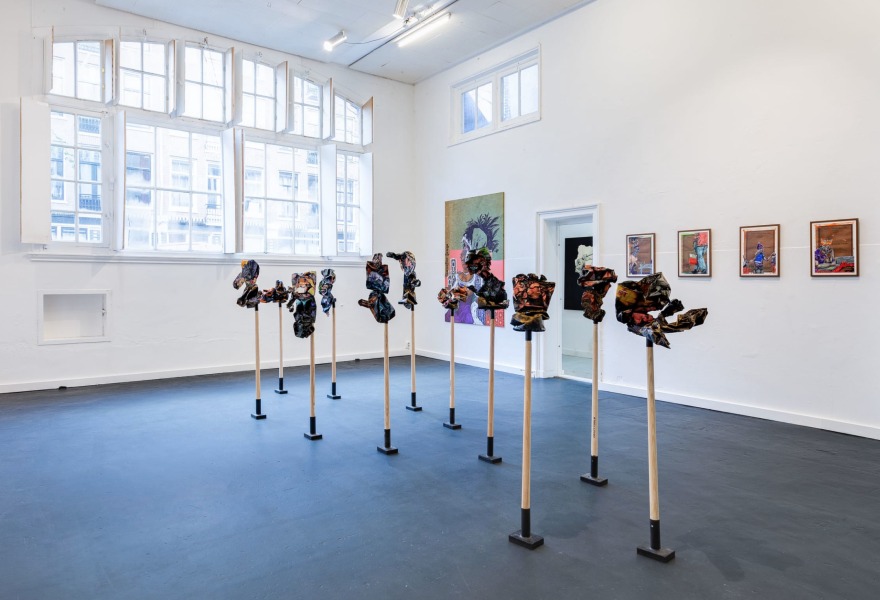12 december 2023, Wouter van den Eijkel
The bittersweet taste of chocolate
Mobembo, the first Dutch gallery exhibition by Congolese Rijksakademie alumni Fransix Tenda Lomba, tells the story of chocolate, from the extraction of cocoa to the bar on the supermarket shelf – and all the social, cultural, economic and (geo)political 'shocks' that characterise the production chain. Le Choc est Là (The Choc/Shock is Here) is one of the series on display. The chocolate has arrived... But do not ask how or at what expense.
Fransix Tenda Lomba (Kinshasa, DRC, 1984) graduated from the art academy in Kinshasa in 2006 and has been involved with the Kin Art Studio in Kinshasa ever since. His work includes drawings, paintings, sculptures and video animations, with his drawings forming the basis of his video work. He often uses materials from his personal archive or that of his parents, combining it with larger historical narratives. He has been a resident at the Rijksakademie in Amsterdam for the past two years. During the Open Studios last summer, Tenda Lomba showcased his series Le Choc est Là. The Window Maps series also focuses on the cultivation of cocoa.
Also on display is an installation of sculptures reminiscent of the looting of an industrial district in Kinshasa in the 1990s, as well as work related to the looting of the Ministry of Education during that same period.

Fransix Tenda Lomba, Bana Ya Limete IV, 2023, Galerie Fleur & Wouter
Le choc est là
The chocolate has arrived... But do not ask how. It is a title with a double meaning. On the one hand, 'choc' refers to chocolate as we all know it, while on the other hand, it refers to the shock, or as Tenda Lomba calls it, the ‘mismanaged benediction,' that the global cocoa trade has meant for the populations of Congo, Ghana and Ivory Coast, among other countries.
During the Open Studios, Tenda Lomba's presentation clearly stood out amid the plethora of video art, partly because he provided viewers with enough points of reference to understand the complex story without further explanation. Most visitors will instantly recognise the elephant from the Cote d’Or logo and identify the likeness of the King Leopold II of Belgium. While the notion of fair cocoa production is not entirely unknown, our attention is usually directed towards it in the supermarket, where brands like Fair Trade chocolate and Tony Chocolonely address today’s issues within the chocolate production chain.

Fransix Tenda Lomba, Joint Power, 2023, Galerie Fleur & Wouter
But Tenda Lomba's analysis goes beyond that. He also considers the effects on local communities over the centuries and the global interdependence created by the cocoa trade. The role of the Netherlands is not left unmentioned. Joint Power, for example, shows a portrait of Mary II, wife of Stadhouder-King William III of Orange. Mary's influence on Dutch culture at that time was not limited to English gardens and ceramics; she also had numerous historical figures executed in chocolate and this practice found followers. The crown in Crown is that of the Dutch monarch and alludes to the prominent role our ports played in trade in cocoa beans and thus in the chocolate production chain.

Fransix Tenda Lomba, Crown, 2023, Galerie Fleur & Wouter
Window Maps
In terms of content, Tenda Lomba's work is therefore reminiscent of artists like Otobong Nkanga, who links the devastating effects of raw material and rare metal extraction to global capitalism and Western consumerism, and Thiery Oussou, who addresses our ignorance about the kind and quantity of work needed for something as simple as a cotton T-shirt.
In his series Window Maps (2023), Tenda Lomba does something similar to Oussou. On wooden panels, he has painted the shape of one of the countries where cocoa is harvested. He has blackened the area around the country and in the 'interior,' we see a scene of cocoa harvesting. He directs our gaze to a reality beyond our field of vision. Tenda Lomba painted these scenes in a pointillist style, a method as laborious and time-consuming as cocoa cultivation.

Fransix Tenda Lomba, Window Map II, 2023, Galerie Fleur & Wouter
A bridge between two countries
Tenda Lomba got the idea for the series from a book he read about the global cocoa trade and decided to develop it further through a series of discussions with advisors at the Rijksakademie. Studies usually form the basis of his work, something that is not common in Congo. "In Congo, artists are mainly seen as craftsmen. They are judged on formal aspects, as a draftsman or sculptor, not as someone who has something to say. To me, information precedes the work," explains Tenda Lomba in the gallery.
"At the Rijksakademie, people give you advice. They don't say ‘do this or that’, but ask if you have considered something. I very much enjoyed that approach." Nowadays, Tenda Lomba has a studio in IJburg and is considering bringing over a few artists from Congo each year to follow the same path as he did. "I want to form a bridge between both countries."
Mobembo is on display at Galerie Fleur en Wouter in Amsterdam until 23 December.
